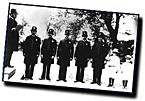As
President, Bill Clinton deals with many major issues that affect all of
us -- crime, drugs, and the environment, just to name a few. However, when our
16th President, Abraham Lincoln (1861-1865), was in office, times were
very different. President Lincoln is well known for his leadership during
the Civil War and for signing the Emancipation Proclamation, which freed
the slaves. However, did you know that he also established the United
States Secret Service?
When the
United States Secret Service (USSS) was established, its main duty was to
prevent the illegal production, or counterfeiting, of money. In the
1800s, America's monetary system was very disorganized. Bills and coins
were issued by each state through individual banks, which generated many
types of legal currency. With so many different kinds of bills in
circulation, it was easy for people to counterfeit money. During
President Lincoln's Administration, more than a third of the nation's
money was counterfeit. On the advice of Secretary of the Treasury Hugh
McCulloch, President Lincoln established a commission to stop this rapidly
growing problem that was destroying the nation's economy, and on April 14,
1865, he created the United States Secret Service to carry out the
commission's recommendations.
The Secret Service officially went
to work on July
5, 1865. Its first chief was William Wood. Chief Wood, widely known for
his heroism during the Civil War, was very successful in his first year,
closing more than 200 counterfeiting plants. This success helped prove
the value of the Secret Service, and in 1866 the National Headquarters was
established in the Department of the Treasury building in Washington, D.C.
During the evening of the same
day President Lincoln established the Secret Service, he was assassinated
at Ford's Theatre in Washington, D.C., by John Wilkes Booth. The country
mourned as news spread that the President had been shot. It was the first
time in our nation's history that a President had been assassinated. As
cries from citizens rang out, Congress began to think about adding
Presidential protection to the list of duties performed by the Secret
Service. However, it would take another 36 years and the assassination of
two more Presidents -- James A. Garfield (March 4, 1881-September 10, 1881)
and William McKinley (1897-1901) -- before the Congress added protection of
the President to the list of duties performed by the Secret Service.

President
Theodore Roosevelt's son Archie salutes as his brother Quentin stands at
ease during a roll call of the White House Police. The White House Police
eventually came to be known as the Uniformed Division of the Secret
Service. Photo Courtesy of the Library of
Congress
Since 1901, every President from
Theodore
Roosevelt on has been protected by the Secret Service. In 1917, threats
against the President became a felony (a serious crime in the eyes of the
law), and Secret Service protection was broadened to include all members
of the First Family. In 1951, protection of the Vice President and the
President-elect was added. After the assassination of Presidential
candidate Robert Kennedy in 1968, President Lyndon B. Johnson (1963-1969)
authorized the Secret Service to protect all Presidential candidates.
Today's Secret Service is made up of
two primary divisions -- the Uniformed Division and the Special Agent
Division. The primary role of the Uniformed Division is protection of the
White House and its immediate surroundings, as well as the residence of
the Vice President, and over 170 foreign embassies located in Washington,
D.C. Originally named the White House Police, the Uniformed Division was
established by an Act of Congress on July 1, 1922, during President Warren
G. Harding's Administration (1921-1923).
The Special Agent Division is charged with two
missions: protection and investigation. During the course of their
careers, special agents carry out assignments in both of these areas.
Their many investigative responsibilities include counterfeiting, forgery,
and financial crimes. In addition to protecting the President, the Vice
President, and their immediate families, agents also provide protection
for foreign heads of state and heads of government visiting the United
States.

The Secret Service protects President Dwight D.
Eisenhower (1953-1961) and his motorcade. Photo
Courtesy of the National Archives
|

